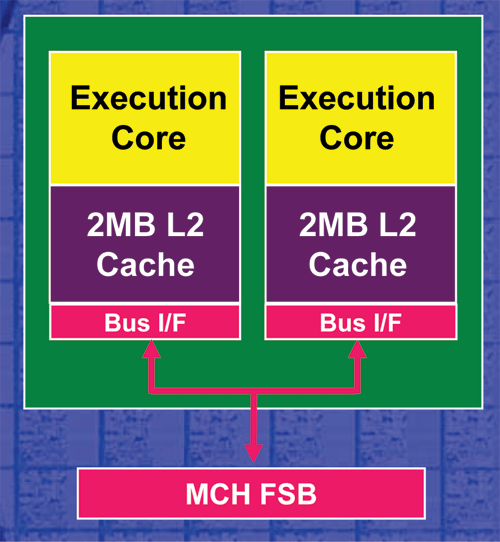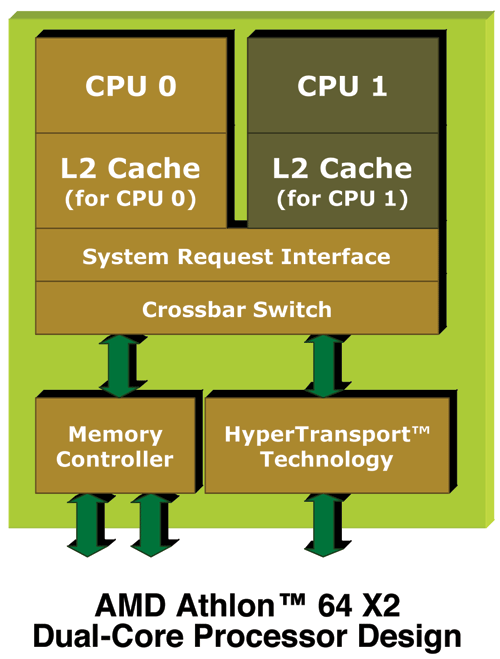AMD's dual core Opteron & Athlon 64 X2 - Server/Desktop Performance Preview
by Anand Lal Shimpi, Jason Clark & Ross Whitehead on April 21, 2005 9:25 AM EST- Posted in
- CPUs
A Look at AMD's Dual Core Architecture
Even Intel will admit that the architecture of the Pentium D is not the most desirable as is two Pentium 4 cores literally glued together. The two cores can barely be managed independently from a power consumption standpoint (they still share the same voltage and must run in the same power state) and all communication between cores must go over the external FSB. The diagram below should illustrate the latter point pretty well:
Intel's Pentium D dual core architecture
AMD's architecture is much more sophisticated, thanks to the K8 architecture's on-die North Bridge. While we normally only discuss the benefits of the K8's on-die memory controller, the on-die North Bridge is extremely important for dual core. Instead of having all communication between the cores go over an external FSB, each core will put its request on the System Request Queue (SRQ) and when resources are available, the request will be sent to the appropriate execution core - all without leaving the confines of the CPU's die. There are numerous benefits to AMD's implementation, and in heavily multithreaded/multitasking scenarios, it is possible for AMD to have a performance advantage over Intel just because of this implementation detail alone.

AMD's solution to the problem will come in the form of DDR2 and a new socket down the road, but for now there's no getting around the memory bandwidth limitations. Intel is actually in a better position from a memory bandwidth standpoint. At this point, their chipsets provide more memory bandwidth than what a single core needs with their dual channel DDR2-667 controller. The problem is that the Intel dual core CPUs still run on a 64-bit wide 800MHz FSB, which makes Intel's problem more of a FSB bandwidth limitation than a memory bandwidth limitation.
Backwards Compatibility
Intel's dual core Pentium D and Extreme Edition won't work in any previous motherboards, but as we mentioned at the start of this article, AMD has more bang. Here, the additional bang comes from the almost 100% backwards compatibility with single-core motherboards. We say "almost" because it's not totally perfect; here's the breakdown:- On the desktop, the Athlon 64 X2 series is fully compatible with all Socket-939 motherboards. All you need is a BIOS update and you're good to go.For desktop users, the ability to upgrade your current Socket-939 motherboards to support dual core in the future is a huge offer from AMD. While it may not please motherboard manufacturers to lengthen upgrade cycles like this, we have never seen a CPU manufacturer take care of their users like this before. Even during the Socket-A days when you didn't have to upgrade your motherboard, most users still did because of better chipsets. AMD's architectural decisions have made those days obsolete. The next generation of dual core processors will most likely need a new motherboard, but rest assured that you have a solid upgrade path if you have recently invested in a new Socket-939 desktop system or Socket-940.
- For workstations/servers, if you have a motherboard that supports the 90nm Opterons, then all you need is a BIOS update for dual core Opteron support. If the motherboard does not support 90nm Opterons then you are, unfortunately, out of luck.










144 Comments
View All Comments
Nighteye2 - Thursday, April 21, 2005 - link
Small observation: in the article DDR2 is mention as a solution to AMD memory bandwidth, while in the news posts there's a bit about AMD skipping DDR2...Anyway, that being said, it's looking good...I wonder how long until there'll be sub-300 A64 X2's available? ^_^
Also, about the hardware problems...isn't running a dual-socketed MB with a single CPU asking for trouble?
Spacecomber - Thursday, April 21, 2005 - link
I really enjoyed taking a look at what you could bring us about these upcoming Athlon dual core processors. It looks like dual core will be the future for all of us, at least at some point.Just a quick comment on the price comparisons that you provided between the dual core opterons and their single core predecessors, I found it interesting to compare prices on the basis of the number of cores.
So,
Opteron 248: 2x$455=$910
Opteron 174: $999
Opteron 848: 4x$873=$3492
Opteron 275: 2x1299=$2598
Assuming the performance scales simply based on the number of cores involved, the pricing of the new dual core opterons looks more attractive.
Space
Quanticles - Thursday, April 21, 2005 - link
pwntfishbits - Thursday, April 21, 2005 - link
It's odd that some picture game developers immediately supporting the PhysX chip as soon as it's available, but think they'll drag their feet to take advantage of another whole CPU core at their disposal.Maybe that will be the reality though, as MT programming is supposed to be a lot harder. Still, to be able to get a game out the door that blows away any of the competition, it might happen sooner than we think. And I could see how Intel would want to push this along to help their sales, and might contribute resources towards making it happen. "OMG, that new game is great, but it totally rules on a new dual core rig! Saw it at my friend's house the other day!"
Who knows, maybe games'll gobble up that second core so fast, it won't be long before we complain about how sluggish the system is when multi-tasking, and that we're shutting down background processes, anti-virus, etc all over again. "We need quad core!" :P
Aenslead - Thursday, April 21, 2005 - link
Ah, well... most of you are forgetting something: sure, the chip's cost is almost 50% higher than the cheapest Intel offer, however, to use a Pentium D, you require a new motherboard (i955x @ 180USD, probably... nF4 IE @ 200USD), AND DDR2 memory... plus, if you have an AGP card, the PCIe video card as well. That's about 650USD for the whole Intel upgrade. AMD, on the other side, is just the processor, which ends up being FAR cheaper.And that is all I have to say about that.
Jep4444 - Thursday, April 21, 2005 - link
the X2 4400+ does not parralel to the 3500+, it parallels to the upcoming socket 939 3700+(which a 939 4000+ could be underclocked to compare)the 3500+ would be best compared to a X2 4200+
the X2 4600+ is dual 3800+ and the 4800+ are dual 4000+
xtknight - Thursday, April 21, 2005 - link
It's too bad that gamers or people that don't multitask are basically left in the dark (extra-performance-wise) by dual-core. I'm not going to break the bank for something that's going to give me less performance than I already have.There's multitasking and then there's multitasking. One kind is having a main program up that gets most of the CPU's attention and another BitTorrent or whatever that's taking up <5% CPU. Usually I'm not trying to encode a video while I play a game, which would be the other type of multitasking. Only the second kind would greatly benefit from these new CPUs, which is a shame. In the first multitasking type I talked about, dual core will improve responsiveness but not raw processing performance.
Does this mark the end for single-threaded performance? Programmers will have a hell of a time creating dual core-beneficial applications, unless by nature the program would benefit from it (i.e. a game server browser, or an AI-heavy game). If the PhysX chip comes through, dual-core won't help too much with physics either. The only benefit that would ever see the light of day for me is the fact that the rest of my system isn't lagged while something else is taking up 100% CPU. For example I could still move my mouse and use Windows Explorer while I'm compressing some files with WinRAR. Even then these scanarios don't come up too often for me personally.
When it comes to raw number crunching performance, the dual-core CPUs don't show any improvement over single-core ones. Sadly enough I think it's going to take forever for programmers to multi-thread their applications. That being said, any program I make from now on will be multithreaded as much as possible.
AtaStrumf - Thursday, April 21, 2005 - link
Nice review as usual :-)...but I do have one complaint. I would like to have seen a top of the line Intel single core CPU (there were no single core P4s in your tests) compared to "X2 4400+" and a 3500+ 939 Athlon 64 which runs at the same 2,2 GHz as the "X2 4400+" to see a direct effect of the second core instead of the 2,4 GHz 3800+.
Some multitasking tests were a bit weird, dare I say unrealistic, but OK for starters. The way I multitask is usually a bunch of IE windows (12 ATM), one folding at home client, 3 - 6 bittornado clients, 1 or 2 (sometimes more) word documents, 1 or 2 (sometimes more) excel documents, outlook express, possibly Photoshop CS, a bunch of Windows Explorer windows, few notepads, some winzip/winrars every now and then, windows media player playing MP3s, Kaspersky antivirus, a dictionary, ACDsee from time to time, Opera with a few open tabs if IE isn't right for the job, ... and I rarely play any games anymore. OK I think that's it. This is not at all uncommon for me, so I'm really looking forward to dual cores, I'm just very sorry that AMD can't offer anything at a competitive price, so instead of going for a Socket 939 from a socket 754, I might go for an Intel platform. I don't know jet, a lot depends on how hard those PD are too cool. No word on that yet from you. I wonder why?
morcegovermelho - Thursday, April 21, 2005 - link
At AMD site:http://www.amd.com/us-en/Processors/ProductInforma...
Hypertransport Links:
152 - (3 links - 0 coherent links)
252 - (3 links - 1 coherent link)
852 - (3 links - 3 coherent links)
that means they are different. Time to change page 3? ;)
SLIM - Thursday, April 21, 2005 - link
Nice review AT. One small suggestion would be to compare one x75 to two 248s to see the effects of memory bandwidth as well as having two cores communicating directly with each other.BTW, that's pretty damn funny that you have to install new circuit breakers and outlets just to power up the zeons.